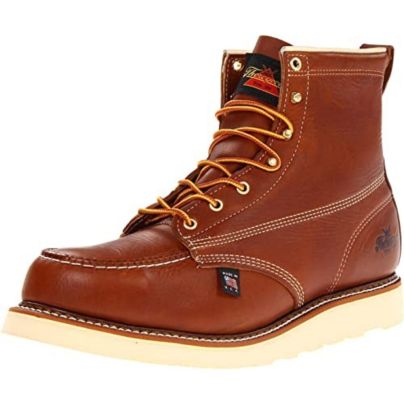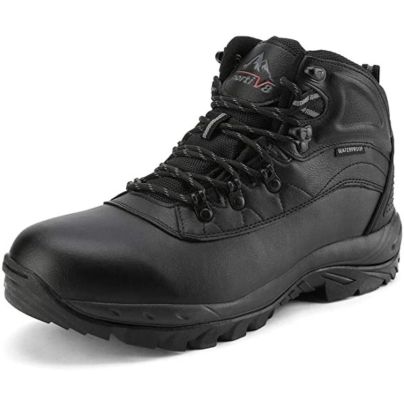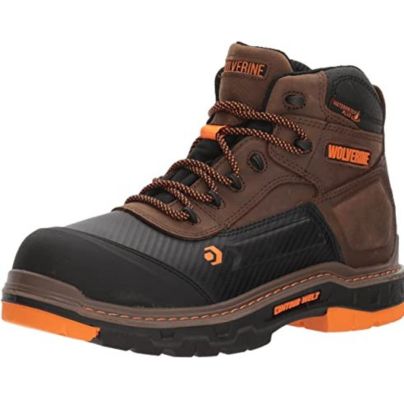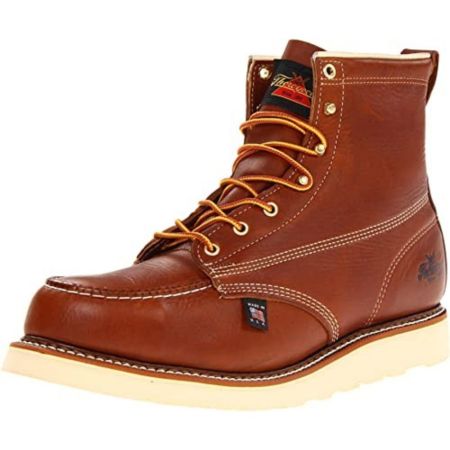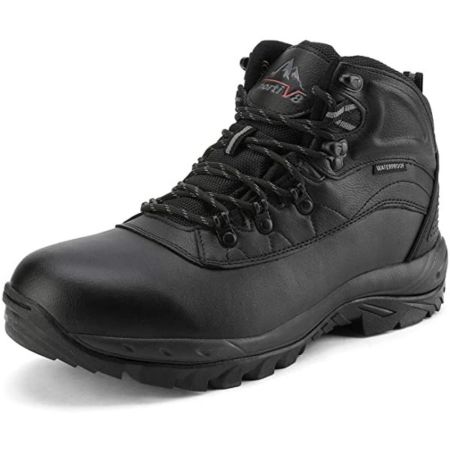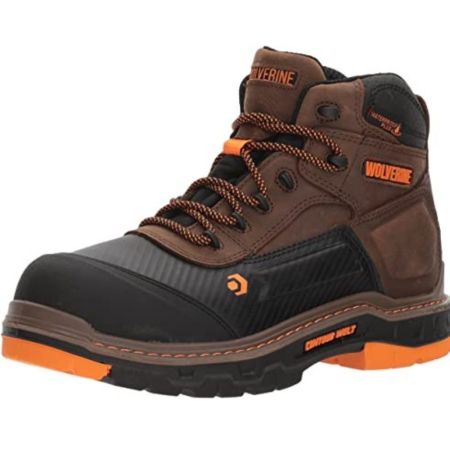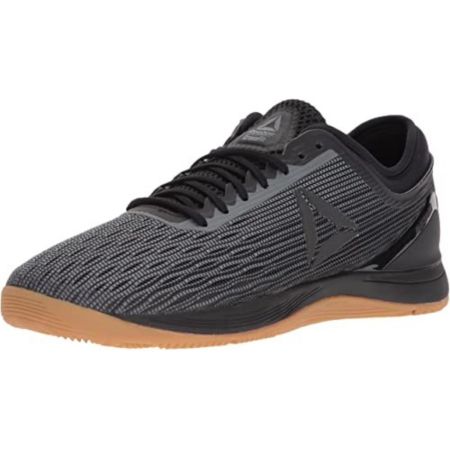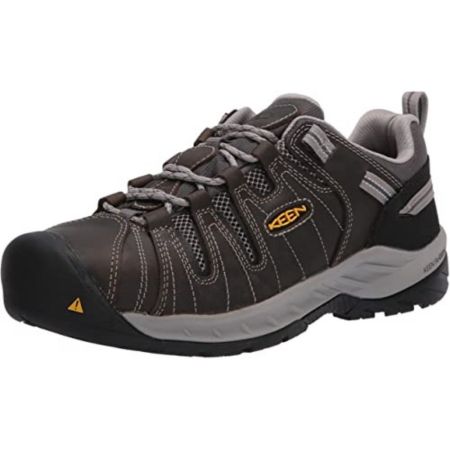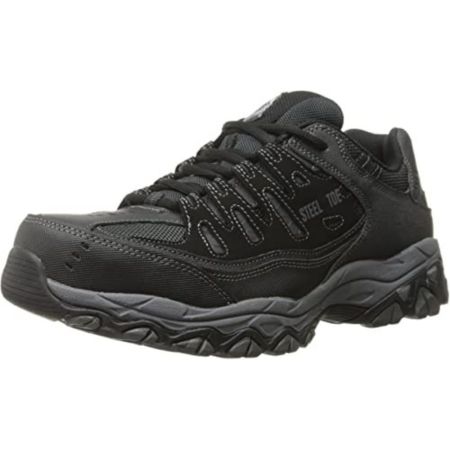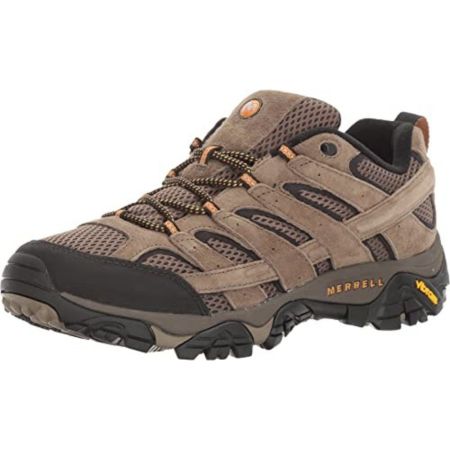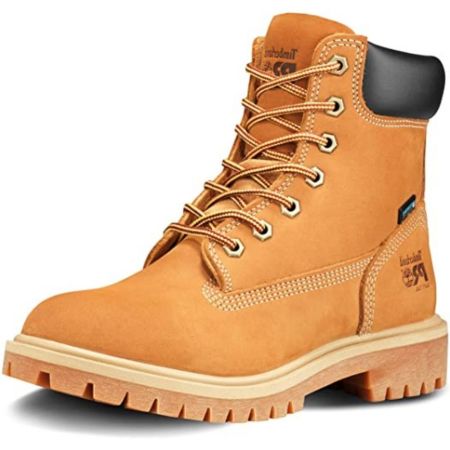We may earn revenue from the products available on this page and participate in affiliate programs. Learn More ›
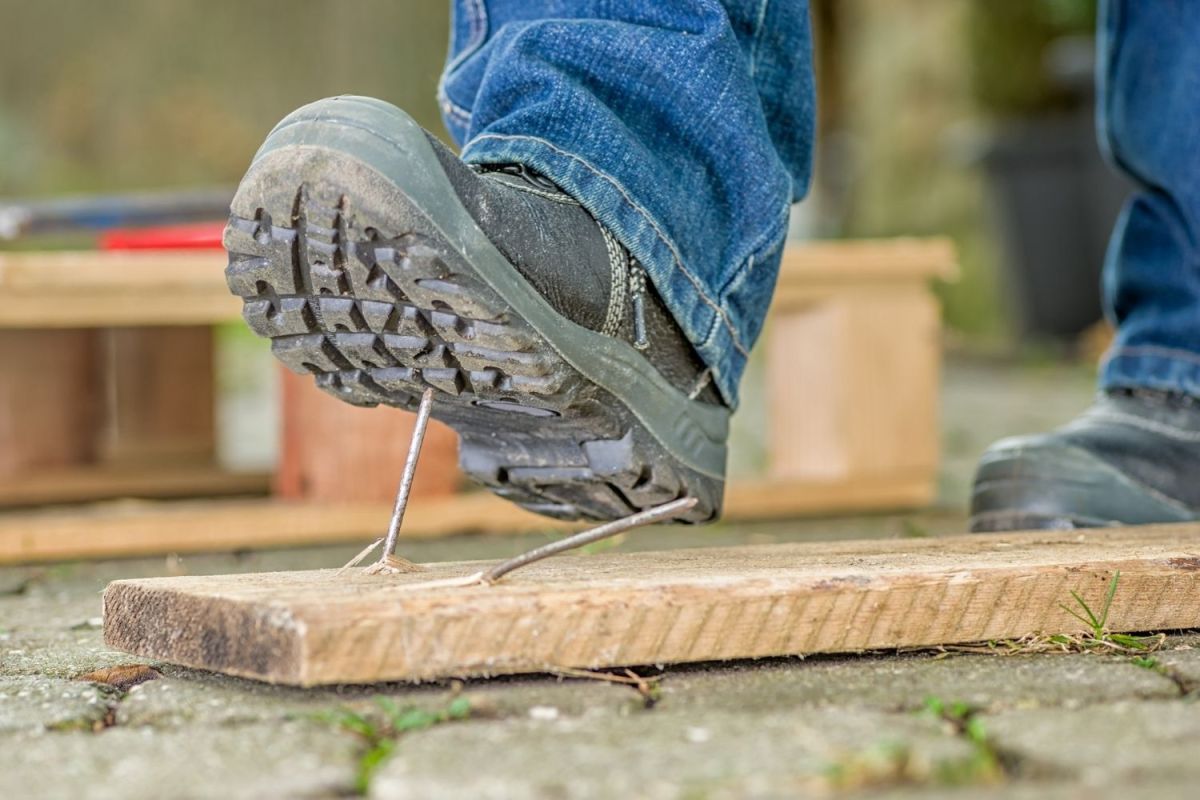
Roofing is one of the more dangerous home improvement projects one can take on. In addition to dangerous elevations, most roofs usually have a pitch that makes slips and falls a significant risk. While such safety precautions as a three-point harness and guardrails are the best safety precautions, it’s also a good idea to equip yourself with a pair of roofing shoes that will provide the best possible traction.
Roofing shoes feature soles with tread explicitly designed with traction in mind. In addition to grip, these shoes also provide cushioning in the footbed for comfort and plenty of ankle support, which is a must when walking on uneven surfaces. Made with leather and suede, they hold up to scraping along the rooftop while working from hands and knees. Roofing shoes also include specialty boots with magnets integrated into the sole for grip in steel roofs, lightweight hiking shoes, and classic leather work boots.
Read on to learn more about what factors to consider when shopping for a pair of shoes for that next roofing project, and find out why the shoes below are some of the best shoes for roofing.
- BEST OVERALL: Thorogood Men’s American Heritage MAXwear Safety Boot
- BEST BANG FOR THE BUCK: Nortiv 8 Men’s Waterproof Hiking Boots
- BEST WATERPROOF: WOLVERINE Men’s Overpass 6” Waterproof Work Boot
- BEST FOR METAL: Reebok Men’s Crossfit Nano 8.0 Flexweave Sneaker
- BEST NONSLIP: Keen Utility Men’s Flint II Non-Slip Work Shoe
- MOST COMFORTABLE: Skechers for Work 77055 Cankton Athletic work sneaker
- BEST LIGHTWEIGHT: Merrell Men’s Moab 2 Vent Hiking Shoe
- BEST WOMEN’S: Timberland PRO Women’s Waterproof Industrial Boot
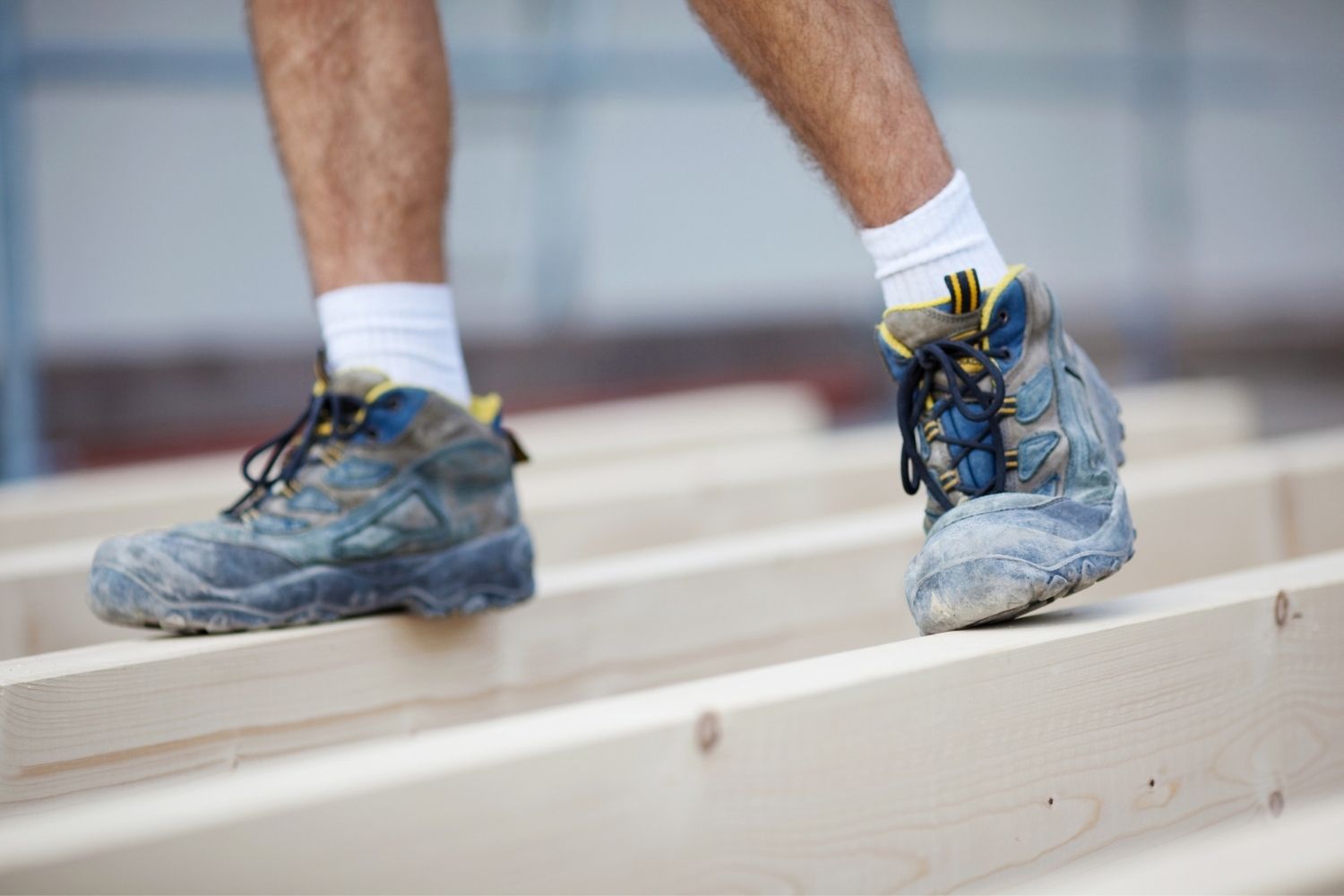
What to Consider When Choosing the Best Shoes for Roofing
Traction and grip may be the most crucial factor when choosing a set of roofing shoes, but it’s certainly not the only factor to consider when shopping for this specialty footwear. Support, comfort, and durability also are high on the priority list.
Traction and Grip
It goes without saying that traction and grip are crucial when working on a roof. Slips and falls can be catastrophic. Traction is especially important given that roofing involves not just walking on the roof but doing so while handling tools and heavy roofing materials. The best roofing shoes have tread patterns that grip rooftops. A good roofing shoe will last about a year before the tread wears thin for professionals that use them daily, and they’ll last many years for weekend warriors.
Some of the best roofing shoes are actually hiking shoes that feature treads optimized for maintaining sound footing on rough and uneven terrain. Boots or shoes with deep and knobby treads work well for preserving traction on rough surfaces, such as asphalt shingles. Shoes with tighter tread patterns are better suited for smooth roof surfaces, such as metal.
Support
Roofing repairs require walking on uneven surfaces with roof pitches that can sometimes be quite steep. A good roofing shoe needs to provide adequate support to prevent your foot from shifting in the footbed and provide support for the ankle. Roofing shoes tend to have higher tops than standard shoes to provide support for the ankle, which endures more stress when standing on a pitched roof.
Comfort and Fit
Whether it’s dance shoes, hiking shoes, or roofing shoes, fit and comfort are always a crucial concern. In the case of roofing shoes, a snug fit is critical to prevent the foot from shifting inside the boot or shoe, which could negatively impact traction. With this in mind, most roofing shoes are lace-up, which allows for a form fit around the foot.
Roofing shoes also should be able to flex to allow for the range of movement required for climbing up 4:12 roof pitches, crawling on hands and feet, or kneeling to attach roofing shingles. Like many work shoes, roofing shoes also have cushioned footbeds that absorb shock, preventing foot fatigue over long roofing efforts.
Material
Although roofing shoes will vary in the materials they use, a thick rubber sole is best for the tread, arguably the most critical part of a roofing shoe. Rubber is durable so the tread won’t wear out quickly, yet malleable enough to grip shingles, preventing slips.
Leather and suede uppers provide enough flexibility to allow for the freedom of movement needed while also being rugged enough to resist abrasions on the top of the boot or shoe when working from hands and knees.
With these elements in mind, many different types of shoes work well as roofing shoes, including many work boots, hiking shoes, and even some sneakers.
Insulation
Not all roofing jobs take place in warm weather. A damaged roof can’t wait until the sun is shining and the weather is warm; that repair needs to happen immediately. That might mean working in cold weather. Your feet need to be warm to ensure safe movement around the roof.
In the summertime, roofing work can be scorching, especially on the feet. Roofing shoes should have thick, insulated rubber soles that protect the feet from the roof’s intense heat. Some roofing shoes are even electrical-hazard (EH) rated, meaning they provide insulation against electric shocks with soles that won’t allow electricity to pass through. This is an important feature when working on roofs with nearby power lines.
Durability
Roofing shoes face harsh conditions, so durability is an issue. Quality roofing shoes use durable materials, including thick rubber roles and leather or suede uppers that will hold up to walking on steep inclines and rough surfaces. They also feature reinforced toes that protect the toe box and sturdy laces that won’t fray or break easily. These shoes protect toes with either steel, hard plastic, or carbon fiber that surrounds the toe box.
Our Top Picks
Some of the best roofing shoes are shown below based on the above considerations, organized by different demands. They include classic work boots for roofing and athletic shoes that work well for roofing.
Best Overall
Thorogood Men’s American Heritage MAXwear Safety Boot
See ItThis classic work boot provides the support, traction, comfort, and durability required from roofing footwear. Thorogood’s MAXWear Wedge slip-resistant tread pattern provides a solid base for climbing roofs, whether asphalt shingle or metal. The leather upper provides plenty of ankle support while still being flexible enough to allow for agile movement. Its Ultimate Shock Absorption footbed keeps feet comfy and protected in inhospitable conditions.
These boots are also electric shock-resistant, capable of withstanding 18,000 volts for up to a minute without allowing current flow. While style may not be a priority on the work site, these boots feature an attractive leather look and are available in two color options in sizes ranging from 10 to 14.
Best Bang for the Buck
Nortiv 8 Men’s Waterproof Hiking Boots
See ItIf you need a good pair of boots for a single roofing job or other infrequent outdoor work, it may not make sense to invest a hundred dollars or more on shoes. These mid-ankle work boots from Nortiv are a great budget option. They feature a waterproof leather upper with tight lacing for a secure fit.
An EVA memory foam footbed provides comfort and shock absorption for comfort. At the same time, a rubber outsole with a tread pattern designed to resist slipping in all directions offers excellent nonslip traction for scrambling around on rooftops. A protective toe cap protects vulnerable toes from injury, while a mid-level height provides adequate support. With eight styles to choose from, these shoes will suit a variety of tastes.
Best Waterproof
WOLVERINE Men’s Overpass 6” Waterproof Work Boot
See ItA leaky roof may require immediate attention, which can mean working in wet conditions. This work boot will keep feet dry until the job is complete, thanks to a waterproof leather upper. This boot also features Wolverine’s Contour Welt construction, which means it will flex at several points, allowing for free foot movement whether walking on an inclined roof, crouching, or crawling.
An Ortholite footbed adds cushioning in the footbed for long workdays. Despite being waterproof, this shoe is breathable, allowing heat to vent and preventing uncomfortable, sweaty feet. Of course, these shoes wouldn’t be suitable for working on a wet roof if the tread didn’t avoid slipping. A thick rubber sole provides plenty of grip for sure-footed movement around a roof.
Best for Metal
Reebok Men’s Crossfit Nano 8.0 Flexweave Sneaker
See ItWhile these shoes may bear little resemblance to a standard work shoe or boot, a closer look reveals this lightweight option is suitable for the unique demands of metal roofing. They feature a flared rubber sole with a tightly patterned weave tread, not unlike a basketball shoe or tennis shoe. This type of tread grips well on steep roofs, including slick metal roofing, while their light weight prevents denting the roof.
Since these shoes are for CrossFit training—which involves a significant amount of squatting, weight lifting, and jumping—they provide excellent stability. They’re also breathable, making them ideal for hot days on the roof. A substantial sole and thick footbed help to insulate the foot from a hot roof, while a large toe box keeps toes comfortable whether climbing or ascending the roof. A lace-up design enables a snug fit. And when the roofing job is over, you can head to the gym without needing to change your shoes.
Best Nonslip
Keen Utility Men’s Flint II Non-Slip Work Shoe
See ItThese shoes may look like something better suited for a hiking trail, but don’t be fooled. The nonslip pattern features small cuts in the rubber tread that are ideal for traction on slick roofing. These shoes won’t just keep one upright while working on the roof; they’re also comfortable, thanks to a compression-resistant midsole that provides 50 percent greater energy-returning bounce than shoes that use standard EVA foam.
The Flint II’s are also electrical-hazard (EH) rated, meaning the soles provide protective insulation if the wearer comes into contact with a live electrical wire. A leather upper is rugged enough to hold up to crawling around on rough roof surfaces while preventing the shoes from causing damage. The Flint IIs come in two color options in sizes ranging from seven to 11.
Most Comfortable
Skechers for Work 77055 Cankton Athletic work sneaker
See ItThose who associate Skechers with 1990s skateboarding might wonder what business these shoes have being on a roof. Given the grip required to perform flip tricks on a skateboard, it makes sense that Skechers might know a few things about traction. This shoe from Skechers’ line of work shoes features the tight tread weave that works well for skateboarding. This tread pattern happens to be an optimal design for gripping rooftops, too.
With a suede mesh upper, a relaxed fit, and a memory foam footbed, this pair is one of the most comfortable work shoes on the market. They also offer features specific to work shoes, including a steel safety toe and a sole that meets safety standards for resisting electric shocks. Skechers work shoes come in four color options.
Best Lightweight
Merrell Men's Moab 2 Vent Hiking Shoe
See ItLightweight hiking shoes have a lot in common with roofing shoes—both must provide excellent traction on uneven rugged surfaces. With a suede leather upper, these shoes present a lightweight option for roofing. Merrell uses Vibram, a rubber sole designed for slip resistance and excellent durability, making them an excellent choice for climbing roofs and hiking backwoods trails.
Heavy-duty laces provide a snug fit while holding up to rugged conditions, while an air cushion sole offers plenty of impact absorption for clamoring about on the roof. A leather mesh upper keeps feet cool on hot roofs by enabling plenty of ventilation. The Moab 2 shoes also come in 17 styles, meeting a variety of preferences.
Best Women’s
Timberland PRO Women’s Waterproof Industrial Boot
See ItWith their thick rubber soles, a tight tread pattern, and substantial ankle support, these women’s boots from Timberland are a worthy choice for roofing repairs. In addition to providing good traction with a tight tread pattern, the thick soles provide excellent insulation to protect feet from hot roofs.
A soft leather upper allows for the freedom of movement needed to walk on pitched roofs while ensuring these boots will be in service for many jobs. Sealed seams make these boots waterproof, keeping feet dry while working in wet weather. Timberland also uses its contoured shock diffusion plate to provide cushioning to reduce foot fatigue. Inside, a moisture wicking lining keeps feet dry while antimicrobial treatment keeps odors in check.
FAQs About Shoes for Roofing
If you still have lingering questions about roofing shoes, then read on for answers to some of the most popular questions.
Q. How are roofing shoes different from regular work boots?
Roofing shoes are a specialized type of work boot. They typically have a different tread style that prevents slipping while walking on a roof. Roofing boots also allow for a greater degree of movement as roofers must walk and kneel on steep inclines comfortably. Some specialized roofing shoes have unique features, such as soles with integrated magnets for walking on steel roofs and replaceable foam rubber pads designed to maximize grip.
Q. Is there any type of footwear I shouldn’t wear for roofing work?
While the light weight and comfort of sneakers may make them a tempting option, most sneakers simply don’t usually have the tread required to create a strong foothold on an inclined roof. They also often lack enough support. Roofing shoes should fit snugly enough that your foot doesn’t push forward in the shoe when standing on an incline, creating painful pressure on the toes and toenails.
Q. What materials work best for roofing shoes?
Roofing materials consist of various materials, including asphalt, clay tiles, slate, and metal. Roofing shoes with beefier treads work well for gripping rough asphalt shingles. These also work well for roofs covered in debris, such as leaves or moss. In contrast, shoes with tighter tread patterns that resemble tennis or basketball shoes work best for smoother metal and slate roofing.
